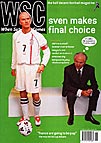 Mathias Kowoll leads us round the grounds that the home nations may or may not be visiting four summers from now
Mathias Kowoll leads us round the grounds that the home nations may or may not be visiting four summers from now
Does anyone remember Sir Bert Millichip’s alleged promise to the DFB (German FA) that England would not bid for the 2006 World Cup because Germany had supported England for Euro 96? Well, Bert himself didn’t. But Franz Böhmert, the president of Werder Bremen, must have recalled it when he found out that the Weserstadion would not be one of the 12 stadiums selected for 2006.
For years, he had been promised that Bremen would be chosen if the club enlarged and upgraded the ground. They did, with considerable financial support from one of Germany’s poorer cities. Yet when Hanover also decided to run, the DFB gave the north’s second berth (the first was reserved for Hamburg) to Chancellor Gerhard Schröder’s home city.
It definitely wasn’t because Hanover had a better ground or more of a football tradition. But no one seriously expected those criteria to be the only ones employed. Leipzig, as the east’s second stadium (after Berlin) was chosen for political and geographical reasons. The new ground has a 44,000 capacity, but the two local fourth division clubs, VfB and Sachsen, currently average gates of fewer than 3,000.
Of the nine venues used in 1974, only Düsseldorf is missing this time. Further south, Stuttgart, Nuremberg and Frankfurt are all respectable football cities (Munich was a banker) with more or less decent stadiums, but it wasn’t only politicians in the west who questioned the inclusion of all of them.
The Ruhr is represented by Dortmund and Gelsenkirchen, of course, and Cologne’s slightly white-elephantish rebuilt Müngersdorfer Stadion is there too. Fans all over Germany would probably have liked Mönchengladbach, with all its fine tradition, to be the west’s fourth venue, but the economic weight of the south tipped the balance. And, some might argue, the fact that the DFB’s president Gerhard Mayer-Vorfelder is from Stuttgart, and its headquarters is in Frankfurt.
Overall, fans will get to see state-of-the-art grounds, most brand new or completely reconstructed, some with breathtaking modern architecture, like Munich’s “rubber boat” (or “toilet seat” to Munich 1860 supporters). And only three with the infamous running tracks. What they will miss is the scent of history, the feeling that hundreds of matches were played here, that millions of fans have populated the stands, sweating, swearing and suffering. Only Kaiserslautern and Dortmund will give you that – and Berlin, but there it will be mixed with the stench of the Nazi Olympics of 1936. After long debate the council decided that the architecture there is worth preserving. So the old Olympiastadion will keep its shell, which will then be filled with a modern stadium. It’s fair to say that Berlin football fans did not have the majority on the decisive committee.
One pick, or rather, non-pick, pleased almost everyone. Leverkusen apparently hoped it would go unnoticed that their squeaky-clean BayArena, Germany’s only all-seater, holds just 22,000, well short of FIFA’s World Cup minimum of 40,000. One stand consists of a measly ten rows of seats plus one giant glass-front of VIP boxes, a McDonald’s and a hotel. The organising committee didn’t fall for it, so Leverkusen withdrew. It may not have been because of the small capacity, however. Maybe they thought of all the Reeboks and Walkers Bowls in England and wanted to emphasise just who it was who had got the World Cup.
From WSC 184 June 2002. What was happening this month